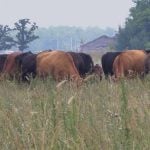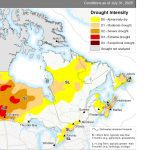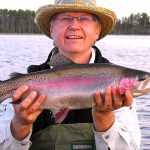Livestock producers with drought-stressed pasture and hay land who are looking to eastern Saskatchewan or the United States for feed may get more than they bargain for, says Clark Brenzil, Saskatchewan Agriculture’s weed control specialist.
“When buying hay and other feeds from a distance, it is difficult, perhaps impossible, to inspect the field for weeds prior to shipment, so anyone buying hay from an unseen site may find a few surprises in subsequent years,” he said.
“The introduction of a new weed species to a piece of land can have lasting cost implications for the management of that land in the future.”
Read Also

Alberta eases water access for riparian restoration
Alberta government removes requirement for temporary diversion licence to water plants up to 100 cubic metres per day for smaller riparian restoration projects
Brenzil said buyers should take a few precautions to prevent this potential scenario. For example, they may contact the municipal office in the area where they are buying hay, and ask the weed inspector to check the hay field for noxious weeds.
The originating municipality is responsible for permits for the movement of plant material infested with noxious weeds. The weed inspector may be able to “certify” shipments as free of noxious weeds prior to shipment. A private agrologist could perform the same task, but for a fee.
“Inspection at the source helps prevent the introduction of new weeds to the buyer’s land,” Brenzil said.
“It also prevents the introduction of these weeds to every farm along the road between the buyer and the seller.”
Additional precautions might be prudent, even with a certified weed-free feed source. Buyers should store hay at a site that is easy to monitor and manage.
It should be checked for weeds for two to three years, and emerging weeds should be destroyed with recommended management practices. The delivery truck should be cleaned thoroughly before it leaves the area.
Producers might also want to manage manure from cattle that are fed imported hay.
“It should be stored separately from manure produced while cattle are on local feed, and the pile should be monitored for new weeds growing on its surface.
“Because composting manure while pile temperatures are high reduces the viability of many weed seeds, more aggressive management of the pile is also suggested. Weed-seed viability in liquid manure is nearly zero after a couple of months in storage,” said Brenzil.
Equipment used for feeding imported hay or for manure management after feeding imported hay should be cleaned prior to use for other purposes.
Brenzil said cattle that eat imported feed should be given feed from local known sources for three or four days before re-introducing them to pasture. This allows weed seeds in the digestive tract to be passed while the cattle are eating feed known to be weed-free.
New weed seeds might be introduced despite these precautions, so producers are advised to monitor their pastures once or twice a year.
Late July to early August is a good time to check for new weeds because many plants flower then and will be more conspicuous. Leafy spurge is an exception, because it flowers in June.
“These precautions may seem like a huge bother, but they are insurance against losses resulting from the introduction and establishment of a new invasive weed on productive land,” Brenzil said.
“Just ask those who now have an infestation of leafy spurge or scentless chamomile due to imported feed. Their answer would likely confirm the worthwhile nature of these precautionary efforts.”
















